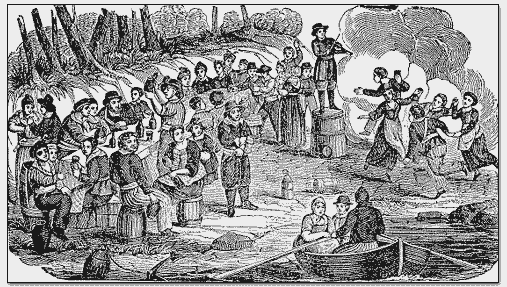Sea Shanties and Pirate Songs
In modern popular culture that often romanticized past events has learned us anything, it is that the Golden Age of Pirates that happened in late 17th and early 18th century was filled with many adventurous pirate crews who all used theatricality during their sea raids, carried identical-looking Jolly Roger flags, sent prisoners to “walk the plank”, and sail while singing some of the many popular sea shanties. However, the reality was different and in it pirate life and exploits were often much different than the modern written, visual and interactive media likes to portray it. One of the myths that is present in almost every modern retelling of pirate lifestyle is that they enjoyed singing pirate songs and sea shanties. This is simply not true, or at least in the sense that their singing was no different than on the ship crews of any other ships during their time. As historians are concerned, organized singing of sea shanties by the maritime crews simply did not happen during 17th and 18th century, but such activities gain big popularity both on sea and in media during 19th centuries when several writers started to include songs they heard by American ship crews who embraced songs they heard by the US dock workers (who were often African American slaves).
The origin of early sea shanties can be traced all the way back to 1549 in the pages of the Scottish book “The Complaynt of Scotland” that described the detailed life, vocabulary and traditions of Scottish seamen of that period. Those songs were described simply as work songs that accompanied organized events (such as raising of an anchor, working on sails or other types of labor). As such, these songs did not differ much from the songs sang by work crews on land. Several centuries after, sea songs started appearing on the American merchant vessels some decades before the start of the American Civil War (1961 – 1965). By then, the very first records of the name “sea shanty” also appeared in the public, with many believing that this name was crafted from the French word “chanter” which means “to sing”. As pre-steam engine maritime technology became more and more advanced, the work needed from ship crews became more complicated which popularized more and more sea chanties.
The popularity of sea shanties reached its peak during the 1950s when large groups of European emigrants chose to act on the gold rush movements and settle California and Australia. This prompted the popularization of the songs that are remembered to this day, such as “Stormalong”, “One More Day”, Across the Western Ocean”, A Hundred Years Ago” and “Haul on the Bowline”.
Arrival of steam-powered ships almost brought the end of sea shanties on the sea (they survived because the need to manually load ship furnaces with coal and maintain various pumps and equipment), but book and film authors of late 1800s and early 1900s continued to inject such songs into their projects, creating often romanticized version of shanties with exception being some organized efforts to preserve original singing of sea shanties by recording them with early audio equipment between 1920s and 1940. One of the most celebrated books covering the history of sea shanties was Stan 'the last shantyman' Hugill's “Shanties from the Seven Seas” from 1961. He provided incredibly detailed all types of shanties, including modern songs that were sung after the 1920s and even non-English songs that were sung across all across the world. As for romanticized view on shanties, the best early example of such books came from Robert Louis Stevenson in his 1883 novel ”Treasure Island” where pirates sang the song "Fifteen men on the dead man's chest".
